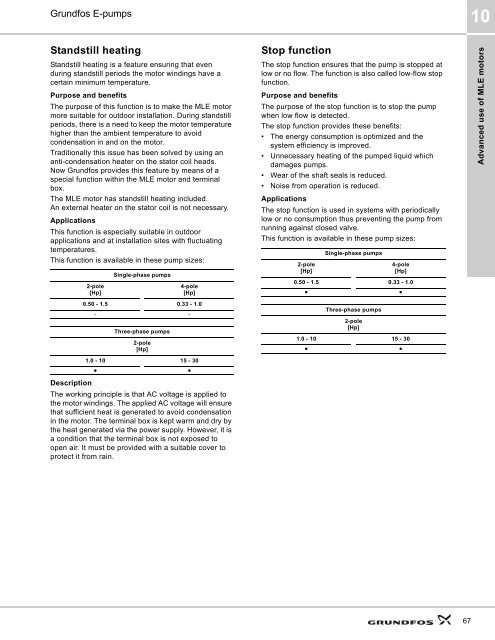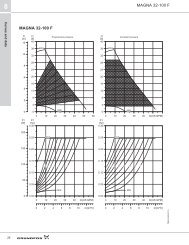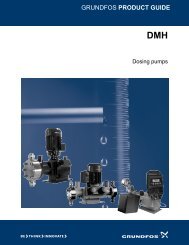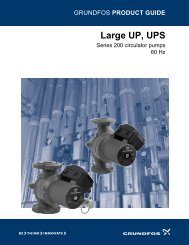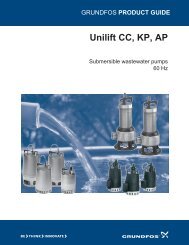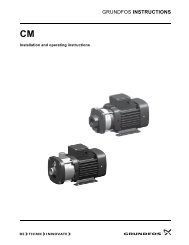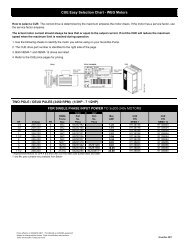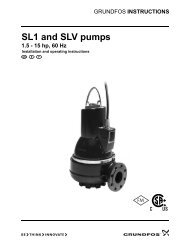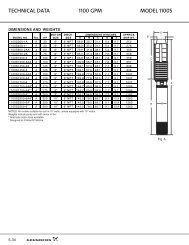You also want an ePaper? Increase the reach of your titles
YUMPU automatically turns print PDFs into web optimized ePapers that Google loves.
<strong>Grundfos</strong> E-<strong>pumps</strong><br />
10<br />
Standstill heating<br />
Standstill heating is a feature ensuring that even<br />
during standstill periods the motor windings have a<br />
certain minimum temperature.<br />
Purpose and benefits<br />
The purpose of this function is to make the MLE motor<br />
more suitable for outdoor installation. During standstill<br />
periods, there is a need to keep the motor temperature<br />
higher than the ambient temperature to avoid<br />
condensation in and on the motor.<br />
Traditionally this issue has been solved by using an<br />
anti-condensation heater on the stator coil heads.<br />
Now <strong>Grundfos</strong> provides this feature by means of a<br />
special function within the MLE motor and terminal<br />
box.<br />
The MLE motor has standstill heating included.<br />
An external heater on the stator coil is not necessary.<br />
Applications<br />
This function is especially suitable in outdoor<br />
applications and at installation sites with fluctuating<br />
temperatures.<br />
This function is available in these pump sizes:<br />
2-pole<br />
[Hp]<br />
Single-phase <strong>pumps</strong><br />
4-pole<br />
[Hp]<br />
0.50 - 1.5 0.33 - 1.0<br />
- -<br />
Three-phase <strong>pumps</strong><br />
2-pole<br />
[Hp]<br />
1.0 - 10 15 - 30<br />
●<br />
●<br />
Description<br />
The working principle is that AC voltage is applied to<br />
the motor windings. The applied AC voltage will ensure<br />
that sufficient heat is generated to avoid condensation<br />
in the motor. The terminal box is kept warm and dry by<br />
the heat generated via the power supply. However, it is<br />
a condition that the terminal box is not exposed to<br />
open air. It must be provided with a suitable cover to<br />
protect it from rain.<br />
Stop function<br />
The stop function ensures that the pump is stopped at<br />
low or no flow. The function is also called low-flow stop<br />
function.<br />
Purpose and benefits<br />
The purpose of the stop function is to stop the pump<br />
when low flow is detected.<br />
The stop function provides these benefits:<br />
• The energy consumption is optimized and the<br />
system efficiency is improved.<br />
• Unnecessary heating of the pumped liquid which<br />
damages <strong>pumps</strong>.<br />
• Wear of the shaft seals is reduced.<br />
• Noise from operation is reduced.<br />
Applications<br />
The stop function is used in systems with periodically<br />
low or no consumption thus preventing the pump from<br />
running against closed valve.<br />
This function is available in these pump sizes:<br />
2-pole<br />
[Hp]<br />
Single-phase <strong>pumps</strong><br />
4-pole<br />
[Hp]<br />
0.50 - 1.5 0.33 - 1.0<br />
●<br />
●<br />
Three-phase <strong>pumps</strong><br />
2-pole<br />
[Hp]<br />
1.0 - 10 15 - 30<br />
●<br />
●<br />
Advanced use of MLE motors<br />
67


